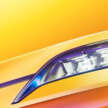It took many, many years, but Mazda announced yesterday that it has produced over two million rotary engine vehicles. This was made possible with the introduction of the MX-30 R-EV, which brings back rotary engine production after 11 years – the last Mazda model to come with the engine is the RX-8 that ended production in 2012.
However, unlike the RX-8, the rotary engine in the MX-30 R-EV doesn’t directly drive the wheels but acts as a range extender for the electric vehicle’s (EV) battery. Such a setup is similar to the one used in the Iconic SP concept presented at this year’s Japan Mobility Show.
It should be noted that Mazda has demonstrated the idea of using a rotary engine as a range extender in the past. Almost 10 years ago, the company revealed a prototype with a range extender rotary engine based on the Mazda 2/Demio EV that was offered in limited units through a leasing programme in 2012.
Older fans of the rotary engine will remember Mazda’s first vehicle with Felix Wankel’s licenced creation being the Cosmo Sport (or 110S), which was introduced in 1967. This car paved the way for the many other rotary-equipped vehicles that followed, including the Familia Rotary (R100), first-gen Luce Rotary (R130), Capella Rotary (RX-2), Savanna (RX-3) and second-gen Luce Rotary (RX-4).
This list continues with the Rotary Pickup (REPU), Parkway Rotary, Roadpacer AP, second-gen Cosmo AP (RX-5), third-gen Luce (929L), first-gen Savanna RX-7, third-gen Cosmo, fourth-gen Luce Rotary (929), fourth-gen Cosmo, third-gen RX-7, RX-8 and to today’s MX-30 R-EV.
“The rotary engine is a special part of Mazda history and represents our ‘never-stop challenging spirit.’ The rotary engine is much loved by customers around the world, and we are excited to resume production and see it make a comeback,” said Takeshi Mukai, director and senior managing executive officer at Mazda.
“I would like to take this opportunity to sincerely thank everyone who has supported us on this journey – in particular, the many customers who have purchased rotary engine vehicles, our rotary engine fans and all our business partners who were involved in development and production,” he continued.
“Moving forward, we will continue to pass on this ‘never-stop challenging spirit,’ offering attractive vehicles that provide our customers with an exciting driving experience even in the age of electrification,” he ended.
GALLERY: 50 years of Mazda rotary engine development
The post Mazda rotary engine production crosses two million units – from the 1967 Cosmo Sport to the MX-30 R-EV appeared first on Paul Tan’s Automotive News.




